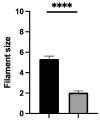Shear Wave Elastography of the Skin following Radial Forearm Free Flap Surgery in Transgender Patients: Observational Study
- PMID: 39201045
- PMCID: PMC11355479
- DOI: 10.3390/jcm13164903
Shear Wave Elastography of the Skin following Radial Forearm Free Flap Surgery in Transgender Patients: Observational Study
Abstract
Background: Ultrasound shear wave elastography (SWE) noninvasively measures the stiffness of tissue by producing and measuring tissue deformation. Scar formation, a crucial aspect of wound healing, can lead to functional and aesthetic complications when pathological. While SWE has shown promise in dermatological evaluations, its role in surgical scar assessment remains underestimated. Our study aims to investigate SWE in evaluating surgical scars at the donor site after forearm free flap surgery in transgender patients. Methods: After radial forearm free flap harvesting, the donor site was grafted with a split-thickness skin graft with or without interposition of Matriderm. Eleven patients were evaluated more than one year after surgery, using SWE alongside scar characteristics, sensory outcomes, and patient satisfaction surveys. Results: Our study revealed no significant difference in stiffness (p > 0.15), pigmentation (p = 0.32), or erythema (p = 0.06) between operated and non-operated sides. The interposition of Matriderm did not influence the stiffness. Patients significantly (p < 0.0001) reported a loss of discrimination. Patients' subjective scar evaluation appeared in line with our quantitative and objective results. Conclusions: This study contributes to the evolving understanding of SWE's role in scar assessment, highlighting its feasibility in evaluating surgical scars. However, continued research efforts are necessary to establish SWE as a reliable and objective method for surgical scar evaluation and management.
Keywords: Patient and Observer Scar Assessment Scale (POSAS); radial forearm free flap; shear wave elastography; transgender; ultrasound; wound healing.
Conflict of interest statement
The authors declare no conflicts of interest.
Figures





Similar articles
-
MatriDerm Decreases Donor Site Morbidity After Radial Forearm Free Flap Harvest in Transgender Surgery.J Sex Med. 2017 Oct;14(10):1277-1284. doi: 10.1016/j.jsxm.2017.08.003. Epub 2017 Aug 23. J Sex Med. 2017. PMID: 28843466
-
Functional and cosmetic donor site morbidity of the radial forearm-free flap: comparison of two different coverage techniques.Eur Arch Otorhinolaryngol. 2018 May;275(5):1219-1225. doi: 10.1007/s00405-018-4908-5. Epub 2018 Feb 26. Eur Arch Otorhinolaryngol. 2018. PMID: 29480362
-
Coverage of radial forearm flap donor site with full thickness skin graft and Matriderm®: An alternative reliable solution?Ann Chir Plast Esthet. 2020 Jun;65(3):213-218. doi: 10.1016/j.anplas.2019.06.009. Epub 2019 Aug 21. Ann Chir Plast Esthet. 2020. PMID: 31445777
-
The application of shear wave elastography with ultrasound for rotator cuff tears: a systematic review.JSES Rev Rep Tech. 2023 Mar 31;3(3):336-342. doi: 10.1016/j.xrrt.2023.02.008. eCollection 2023 Aug. JSES Rev Rep Tech. 2023. PMID: 37588504 Free PMC article. Review.
-
The anatomy of forearm free flap phalloplasty for transgender surgery.Clin Anat. 2018 Mar;31(2):145-151. doi: 10.1002/ca.23014. Epub 2017 Dec 18. Clin Anat. 2018. PMID: 29178477 Review.
References
LinkOut - more resources
Full Text Sources

